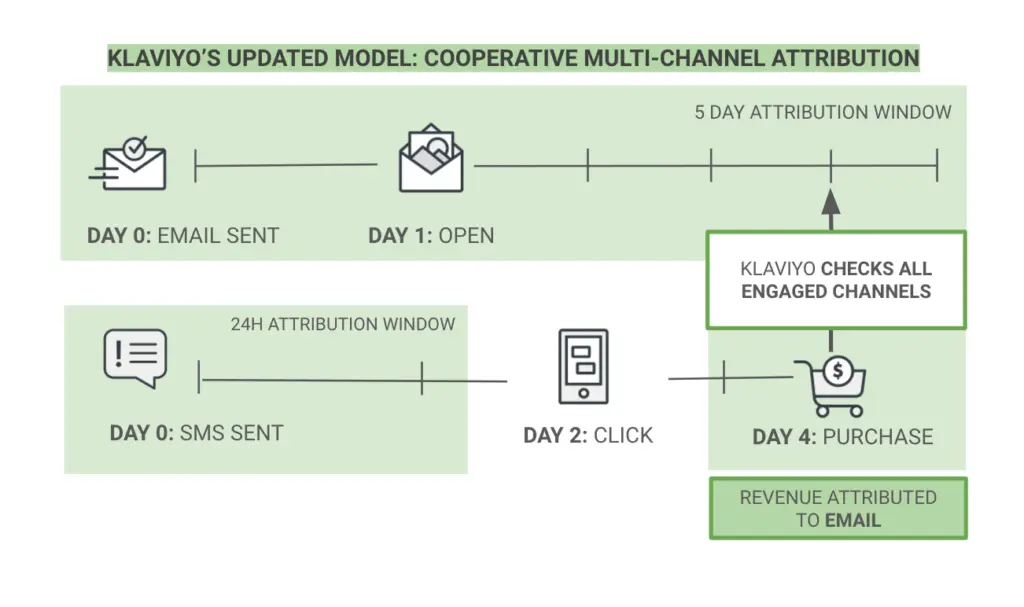Introducing—and explaining—Klaviyo’s updated multichannel attribution model
Today, the Klaviyo team has released an update to our attribution model to provide a more accurate understanding of which channels are having the most impact on your business.
This update will only impact multichannel customers (i.e. those using both SMS and email tools within Klaviyo), but we know accurate attribution is a concern and priority of all marketers.
Here’s what you’ll find in this article:
- A primer on multichannel attribution
- Why treating SMS and email as independent is ineffective
- A cooperative multichannel marketing attribution model for cohesive marketing communications
- Why this update? Why right now?
Learn more about the 7 most common marketing attribution models:
A primer on multichannel attribution
Buyer journeys are not linear. There are many touchpoints that we create as marketers to turn potential buyers into paying customers.
When it comes to understanding what is driving conversions for your ecommerce business, it’s crucial to understand the conversion path and which marketing activities—Google Ads, organic search, social media, retargeting, referrals, paid search, email, or SMS—you should further optimize.
Multichannel attribution helps you get a sense of which channels are or are not contributing to sales.
There are many different attribution models and multichannel funnels used to understand which digital channels contribute to sales—first touch (also known as first touchpoint, first click, or first channel), last touch attribution (also known as last interaction, last touch point, last-click attribution), multi-touch attribution, multi-touch attribution models, time decay models, last non-direct click, linear attribution models, and even custom models.
At Klaviyo, we believe in making it easy to understand how much revenue which channels drive, to make interpreting marketing metrics and conversion data easier to understand and use.
Here are the changes we’ve made, and why.
Always treating email and SMS marketing as independent channels is ineffective
Our new cooperative multichannel attribution model takes into account the shared impact of email and SMS channels used concurrently.
Historically, Klaviyo has incorrectly skipped attributing revenue that should have been attributed to an email or SMS due to attribution window rules.
Reminder:
“Why not attribute the conversion to the email campaign since the conversion still falls within the email’s attribution window,” asked Andrew Walters in the Klaviyo community forum. “It doesn’t make sense to have conversions go unattributed if the customer engages both email and SMS. The SMS message shouldn’t disqualify the influence of the email.”
He’s right, it shouldn’t. But it was.
The graph below explains how Klaviyo’s multichannel attribution used to work.

This lack of email or SMS attribution isn’t painting a clear picture, given that a customer interacted with both channels prior to purchase.
In the example above, the customer interacted with the last channel (SMS) outside of the SMS-specific attribution window and still inside the email attribution window. As a result, no channel received attribution for the purchase even though it happened within the attribution window of email.
We’ve resolved this in our cooperative multichannel attribution update.
A cooperative multichannel attribution model for cohesive marketing communications
In the new model, the Klaviyo platform looks at both the attribution window for each channel and determines if either of those channels should get revenue attribution at the time of purchase.
This means that if the SMS channel’s attribution window has closed, but the email attribution window is still open, and the customer interacted with the email during that time period, attribution will go to the email.

This is part of a cooperative multichannel attribution model in which SMS and email work together to engage existing and new customers with complimentary messages across these two collaborative communication channels.
Why this update? Why right now?
As marketers use more marketing channels along the customer journey, having accurate marketing attribution becomes more important when understanding which marketing efforts are working best.
Google Analytics can only get your understanding of your digital marketing performance so far. Since Klaviyo offers the ability to have multiple touchpoints across multiple channels in your marketing campaigns, having a better understanding of the effectiveness of your marketing strategy is increasingly important.
From product features to our business model, Klaviyo aims to provide full transparency and flexibility to meet all customer needs, and that’s especially important when it comes to attribution.
Klaviyo is one of the only customer platforms that houses both email marketing and SMS marketing in a single system. This is important because SMS and email marketing can play off of one another, reinforce messages, and give brands more opportunities for engagement and conversion.
SMS and email marketing can play off one other.
Our previous multichannel attribution model was not taking this cohesive communication channel strategy into account, and brands were losing visibility into Klaviyo’s Attributed Revenue as a result. When that happened, marketers were unable to tell their brand’s full email and SMS marketing story.
We have made this change to better arm Klaviyo customers using both email marketing and SMS marketing within our platform with the data they need to prove these two channels can be used together to build trust, loyalty, and retention.
Integrated marketing is better marketing, and marketing measurement with properly attributed revenue helps great teams communicate their success effectively.
Multichannel attribution FAQs
Is multichannel attribution only for ecommerce businesses?
No, multichannel attribution is valuable for any business with an online presence, as it helps analyze the effectiveness of various online and offline marketing efforts, not just ecommerce transactions.
What are some common challenges with multichannel attribution?
Some of the biggest multichannel attribution challenges include:
- data accuracy
- privacy concerns
- the complexity of customer journeys
- attributing conversion value to each touchpoint accurately
- ensuring the customer data used for attribution is accurate and consistent across different channels and touchpoints
- Getting buy-in and alignment across different teams and departments within an organization, analytics, sales, and marketing teams may have different perspectives on how attribution should be done and what metrics are most important for data-driven decisions.
How often should I review my multichannel attribution model?
It’s a good practice to regularly review and update your attribution model and integrations, especially when your marketing strategies or customer behavior changes significantly. Quarterly or semi-annual reviews are common, but the frequency can vary depending on your business needs.

